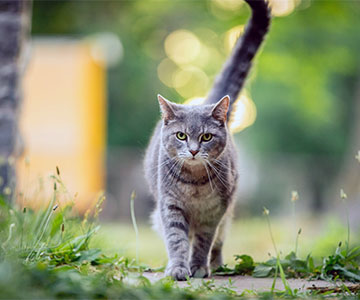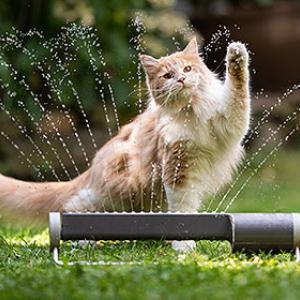Cats and the outdoor world
Cats love to roam through nature and pursue their natural behaviours such as hunting, sneaking, and climbing. Spending time outdoors doesn't just promote exercise and activity, but also social contact with other cats in the neighbourhood. But as well as freedom, there are also some potential dangers waiting outside in the fresh air. Many cat owners face the question of whether to let their cat outside or not.
An outdoor life - pros and cons
Sneaking, lurking, hunting: this behaviours are in a cat's nature. Many cat owners who let their cats roam free outside argue that this is the only way to keep them in a way that is appropriate for their species. But should you leave your cat free to roam? This is not an easy decision.
Cats that are allowed outside can follow their instinctive behaviour more easily. It is much easier to exercise outdoors than indoors. Natural social behaviour can also be promoted in contact with neighbouring cats. For the owner, allowing their cat to roam freely also means less work as the cat will not scratch their furniture, wallpaper, or carpets, and will largely go to the toilet outside. In addition, outdoor cats are less likely to be overweight because they can move around more outside than indoors.
 Many cat owners face the question of whether to let their cat outside or not.
Many cat owners face the question of whether to let their cat outside or not.
But being left free to roam can also be life-threatening for a pet. This is the case, for example, if the cat and cat owner live in a city or on a busy main road. In addition to cars, buses and other vehicles, outdoor cats also face other hazards. Accidents don't always involve a vehicle. If your outdoor cat wears a collar, it can get caught in it, seriously injure itself or, in the worst case, strangle itself. When choosing a collar, it is therefore imperative to look for a model with a safety clasp that opens in an emergency - or to do without the collar altogether. In addition, unneutered male cats in particular can get into territorial fights outdoors - and sometimes they can be bloody. But even neutered cats are not spared territorial disputes. Cats can also get into a fight with neighbourhood dogs or other wild animals, such as martens or foxes.
 Spending time outdoors promotes social contact with other cats in the neighbourhood.
Spending time outdoors promotes social contact with other cats in the neighbourhood.
The legal situation
 Free-roaming cats don't know any property boundaries.
Free-roaming cats don't know any property boundaries.
Checklist before allowing your cat outdoors
- Has the cat been sufficiently vaccinated? (Cat plague, cat flu, rabies, ...)
- Is the cat neutered? This doesn't just avoid unwanted offspring - it also avoids turf wars and ensures your cat doesn't run off too far.
- Is your pet marked with a chip and registered?
- How safe is your residential location? Is there a busy road nearby?
- Has your cat got used to your home? You should give your cat at least 4 to 6 weeks to settle in your home.
- Have you installed a cat flap? During the winter and in bad weather, a cat should have the possibility to quickly return home at any time.
How can you get a cat used to being outdoors?
The best option is to install a cat flap before the first trip outdoors. Otherwise, the cat will regularly demand to have the door opened by you in order to get either outside or inside. By installing a cat flap, you can allow your cat to enter and leave the home whenever it wants. Before your cat goes outdoors for the first time, you should train it to go through the flap.
On the first day out, you can also take a few measures to ensure that your pet's first outing goes as smoothly as possible. Fill your cat's bowl with a little less food than usual on this day, and go outside together for the very first time. Go slowly and see how far your cat is willing to go. Don't shy away from slightly rainy weather either. This will also ensure that your cat will want to return home quickly.
Let your cat explore its environment at its leisure and do not constantly call its name or otherwise try to distract it. Allow your cat enough time to explore everything. Soon, they will feel the need to go outdoors alone again. After the first trip outdoors, reward your cat with its favourite food or toy so that it realises that it is always worth coming home. In the first few days, you can accompany your cat when it goes outdoors, so that you can also intervene in case of any problems.
How can you keep outdoor cats healthy?
The right food for outdoor cats
Outdoor cats are much more active than indoor cats. They consume and require more energy. As they roam around the neighbourhood, they consume far more calories. In addition, an outdoor cat is exposed to more pathogens than an indoor cat. Cats may also be outdoors in cold and wet weather, so they will need good defences and a strong immune system. When feeding outdoor cats, it is therefore particularly important to pay attention to high-quality protein-rich cat food with a high meat content and many healthy nutrients.
Exercise flat cats
 Intelligence toys and food games wear to keep indoor cats busy.
Intelligence toys and food games wear to keep indoor cats busy.
Secured outdoor access
Questions and answers on the subject of outdoor access
Which cat flap is the right one for my cat?
How can I protect my cat from busy roads?
When can I let my kitten outside for the first time?
When can I let my cat outdoors (again) after a move?
What vaccinations does my cat need to go outdoors?
In
addition to the usual vaccinations (cat plague, cat flu), which are also given
to indoor cats, outdoor cats also need protection against rabies.









.png)
.png)
.png)